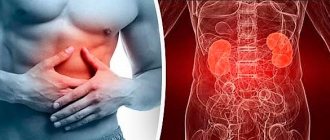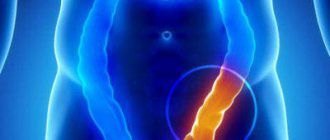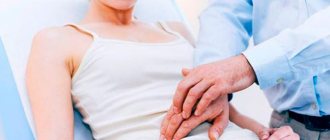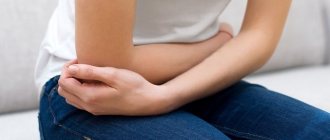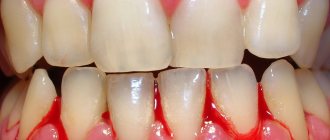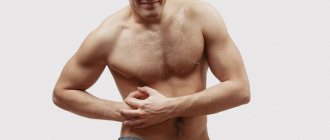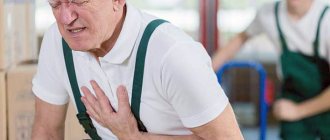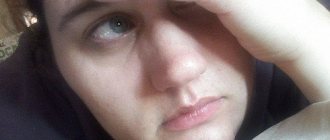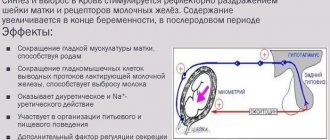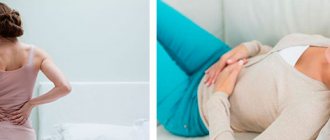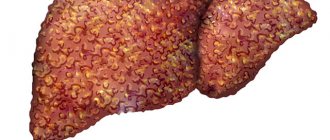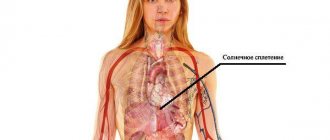Pain in various forms of cholecystitis
Cholecystitis is an acute inflammatory process of the gallbladder.
In a healthy person, bile is excreted from the body through the small intestine, but when problems arise, it begins to accumulate in the gallbladder and with this phenomenon an attack of pain is observed. Signs of cholecystitis are usually pronounced and are a reason to visit a specialist.
Depending on the nature of the disease, cholecystitis is divided into acute and chronic. If the chronic form of cholecystitis is accompanied by the formation of gallstones, it is called the calculous form. Symptoms of cholecystitis vary and depend on the form of the disease.
Pain with calculous cholecystitis
This disease can develop over a long period of time, alternating periods of exacerbation with periods of calm. In medical practice, there are two forms of calculous cholecystitis #8212; acute and chronic, each with different symptoms.
In acute calculous cholecystitis, an attack of biliary colic and the following symptoms are noted:
- An acute attack of pain in the right hypochondrium, which can be reflected in the shoulder or back;
- Periodic attacks of nausea and vomiting, with the vomit containing an admixture of bile;
- High body temperature;
- Low blood pressure;
- Weakness of the body and the appearance of cold sweat.
In acute cholecystitis, the pain is often cramping and can affect the neck, back and right arm. With biliary colic, symptoms of peritoneal irritation develop, that is, examination of the abdomen is accompanied by severe pain and a tense state of the peritoneal walls.
Destructive forms of calculous cholecystitis are accompanied by the fact that pain occurs much more intensely and there is tachycardia, constant vomiting, hypotension and signs of peritonitis.
In chronic calculous cholecystitis, the symptoms of the disease are not very pronounced and have significant differences:
- the occurrence of incessant aching pain in the right hypochondrium;
- the result of eating fatty, salty and fried foods is an attack of pain;
- minor nutritional errors result in an attack of acute pain, which gradually subsides.
- nausea and unpleasant belching;
- frequent and severe headache;
- vomiting mixed with bile.
Pain in chronic cholecystitis
In chronic cholecystitis, microorganisms enter the gallbladder from the intestines and when blood and lymph enter from any other chronic source of inflammation. This disease has a gradual development. Initially, the mucous membrane of the gallbladder becomes inflamed, gradually the inflammation moves to deeper layers and the signs of the disease intensify.
The symptoms that develop with chronic cholecystitis manifest themselves in pain that is felt in the right hypochondrium. In this case, there is irradiation of severe painful sensations in the right lumbar region, scapula and right shoulder.
This disease is characterized by a long course of cholecystitis, which is progressive in nature with periods of exacerbations and remissions:
- With increased tone of the gallbladder muscles, paroxysmal pain is observed for a short time, reminiscent of an attack of biliary colic in cholelithiasis;
- Reduced tone of the gallbladder muscles causes pain that is aching and mild in nature. In some cases, there is a complete absence of pain, and the leading place belongs to a feeling of heaviness in the right hypochondrium.
Such symptoms in chronic cholecystitis develop when the outflow of bile from a distended gallbladder is disrupted.
These striking signs of a chronic disease may be accompanied by complaints of the following symptoms:
- increased body temperature;
- unpleasant bitterness in the mouth;
- recurrent headache
- itchy skin on the arms, back and stomach;
- digestive problems;
- loss of appetite;
- signs of food allergy.
Providing assistance during a pain attack
The nature of the course of cholecystitis, symptoms and features of its complications determine what medical care will be provided during a painful attack of cholecystitis:
- In case of an acute attack of cholelithiasis, where there is no wedging of stones into the ducts, the patient can be treated conservatively. To do this, the patient is hospitalized in a hospital hospital, where appropriate treatment is prescribed. In acute and chronic cholecystitis, a painful attack can be relieved with the help of antispasmodics, antibiotics, infusion therapy and applying cold to the gallbladder area. Timely and correct treatment leads to the fact that the symptoms of pain weaken or completely disappear.
- If there is a large stone or several stones in the gallbladder and various kinds of complications develop, then emergency surgery is performed to remove the gallbladder and restore the patency of the ducts.
- A conservative treatment method is used for the development of chronic acalculous cholecystitis. It is complex in nature and allows you to eliminate inflammation, improve blood flow and prevent the formation of stones. In order to relieve an attack of pain, they resort to the help of antibiotics, antispasmodics, choleretic drugs and digestive enzymes. Completing prescribed medical procedures and taking medications leads to a noticeable reduction in pain symptoms.
Folk remedies for relieving pain
The absence of stones in the acute period and the period of remission is allowed to take choleretic herbs and herbs, which improve the flow of bile and have an anti-inflammatory effect.
Among the variety of herbs, wormwood, milk thistle, tansy and immortelle have a choleretic effect. Preparing and taking infusions from these herbs speeds up the healing process, and the signs of the disease will become less pronounced.
A good effect is achieved by tubage, which can be used provided there are no stones outside of an exacerbation. Thanks to its use, the tone of smooth muscles increases and the outflow of bile improves. The procedure involves taking a solution with magnesium sulfate, mineral water and sorbitol. After this, the patient is recommended to lie on his right side for an hour with a warm heating pad.
The first signs of cholecystitis require mandatory consultation with a doctor, which will avoid serious complications in the future. Good means of preventing the disease is to organize proper nutrition and a special diet, as well as limiting foods high in cholesterol.
Author . Glushakova Tatyana Vladimirovna, especially for the site Moizhivot.ru
Gastroenterologists in your city
Predisposition to disease
Cholecystitis is also possible in children. Parents should pay attention to their child if he:
- yellowness appears on the tongue;
- often lacks appetite and feels slightly nauseous;
- Variable stool disorders occur - constipation gives way to diarrhea and vice versa;
- there are complaints of pain in the liver area.
Such symptoms may indicate a number of problems with the gastrointestinal tract, therefore, to identify cholecystitis, it is important to notice the specific manifestations of this pathology, which are accompanied by pain when palpating the gallbladder and liver, rumbling in the abdomen and flatulence, lack of appetite, and frequent cases of sour belching.
Sometimes children may experience an increase in body temperature, which occurs along with sharp pain on the right side. However, parents should take into account that such symptoms may indicate a number of pathologies (including appendicitis), so they cannot delay; it is better to immediately consult a doctor to determine the diagnosis and begin qualified treatment of the child.
The nature and localization of pain in acute cholecystitis may differ and have non-standard forms. During an ultrasound of the abdominal organs, its condition must be checked, because an attack of this disease can be masked under different forms. The gallbladder is located in the right hypochondrium, where the liver is, and in the classic form of cholecystitis, painful sensations are felt in this area. However, there are also options for how this disease can manifest itself:
- The cardiac form is manifested by pain in the heart area, and heart rhythm disturbances are also observed.
- Thyrotoxic ─ with this form there is an increase in body temperature, rapid heartbeat, and frequent mood swings.
- The rheumatic form is acute pain in the joints and heart area. An ECG can also reveal abnormalities that could indicate cardiac pathologies.
- Neurocerebral ─ occurs against the background of intoxication with bile elements. The patient feels a loss of strength, dizziness, headache, increased sweating, and sleep disturbances.
- The gastrointestinal form is associated with digestive disorders. Bile is involved in the process of breaking down food, and when its flow into the intestines decreases, symptoms such as stool disorders, nausea, vomiting, heartburn and flatulence appear.
- The allergic form occurs as a delayed or immediate hypersensitivity reaction. This is due to the reaction of the immune system to bile components that enter the blood. The patient may develop a skin rash accompanied by itching. In some cases, Quincke's edema develops, which can cause death.
Cholecystitis can be acute or chronic. The acute form is often calculous, as it is more often associated with the appearance of gallstones. Chronic cholecystitis mainly accompanies obesity, stomach and liver diseases, pancreatitis, as well as other metabolic disorders in the body. Pain from cholecystitis may also vary depending on the form, severity of the disease and severity of symptoms.
TEST: What is the condition of your liver? Take this test and find out if you have liver problems.
Start test
Biliary colic can be caused by blockage of the ducts with stones (calculi).
There are reasons for the body’s predisposition to cholecystitis:
- During pregnancy, some women experience compression of the gallbladder. This contributes to a disruption of the acid content in it, as a result of which stagnation can form in the gallbladder. Next, symptoms of cholecystitis occur in women. For an accurate diagnosis, you should consult a doctor.
- The female body is subject to hormonal surges, this is its nature. It has been proven that progesterone, which is actively produced during pregnancy, as well as during menopause, causes malfunctions of the gallbladder.
- Diets and other food restrictions lead to disruption of the contractions of the above-mentioned organ. As a result, symptoms of cholecystitis in women may occur. At the first sign of discomfort, a girl should consult a doctor.
Since gallstone disease is present in the body with this type of disease, treatment is prescribed taking this fact into account. In general, what kind of illness is this?
Gallstone disease involves the formation of stones in the gall bladder. At the initial stage, this disease may not manifest itself in any way.
Forms of cholelithiasis:
- Latent. As a rule, it occurs without any symptoms. This disease can be diagnosed using ultrasound. The stones in this form of gallstone disease are small in diameter. If a person is diagnosed with this, then he needs to contact a nutritionist to receive nutritional recommendations.
- Dyspeptic form of cholelithiasis. This form of the disease is characterized by a dull, aching sensation. Patients also experience gastrointestinal distress. The causes of this form of the disease are fatigue at work and hypothermia.
- Torpid form of cholelithiasis. Its main difference is dull pain after exacerbation of cholecystitis. They are aching in nature. Appear in the solar plexus area.
- Shock form of cholelithiasis. In this case, a person experiences a sharp blockage of the duct from the gallbladder. The patient's skin turns pale, cold sweats appear, the heartbeat quickens, chills occur and acute pain is felt.
Pain with cholecystitis
One of the main criteria in making a diagnosis is the nature and intensity of pain during cholecystitis . The disease can be acute or chronic. Cholecystitis can be calculous (presence of stones in the gall bladder) and acalculous. The presence of stones, the intensity of the inflammatory process, and the patency of the bile ducts determine the nature and intensity of pain in cholecystitis.
Pain with calculous cholecystitis.
In acute calculous cholecystitis, biliary colic occurs. We are talking about acute, severe pain in the right hypochondrium. The pain is often unbearable, cramping, and can radiate to the back, right arm, or neck. If a stone becomes wedged into the bile duct, jaundice appears. With biliary colic, symptoms of peritoneal irritation may appear, i.e. When examining the abdomen, sharp pain in all parts and tension in the abdominal wall are noted. During the examination, you can feel an enlarged, painful gallbladder. Tapping on the ribs on the right causes sharp pain. Pain with cholecystitis intensifies with deep breathing and the slightest movements.
Calculous and non-calculous cholecystitis
- periodically occurring dull or nagging pain in the right hypochondrium;
- irritability;
- bitterness in the mouth, flatulence, belching of air;
- the occurrence of pain in the right hypochondrium and epigastrium after eating fatty, spicy and sweet foods;
- insomnia;
- in rare cases, nausea.
Calculous cholecystitis can also occur in the same way; stones can only be detected during instrumental examination. Calculous and non-calculous cholecystitis may not manifest itself for a significant amount of time, and will manifest itself in the development of complications.
Exacerbation of non-calculous cholecystitis can manifest itself:
- bowel dysfunction;
- fever;
- excessive gas formation;
- bitter taste in the mouth.
Exacerbation of calculous chronic cholecystitis is usually accompanied by darkening of urine and lightening of stool; severe vomiting; steatorrhea; intoxication processes; acute paroxysmal pain in the right hypochondrium and epigastric region, radiating to the neck, forearm, lower back, and scapula; tachycardia and high temperature.
Lower back pain can be caused by Cholecystitis!
Cholecystitis is a medical disease. which results from inflammation of the gallbladder. This condition is often associated with the onset of gallstone formation and concomitant gallbladder infection, the latter leading to lower back pain.
Gallstone disease (the onset of gallstone formation) typically occurs as a result of obesity, estrogen treatment, stone calcification, and the development of gallbladder infections. It can cause chest and stomach pain, and other symptoms that people with the condition experience include shoulder and lower back pain. In the most severe cases, jaundice may also develop.
What is cholecystitis?
The most common symptoms of cholecystitis are flatulence, belching, itching, ecchymosis, dark urine, and discolored stool. In most cases, ecchymosis and lower back pain with cholecystitis are interrelated. This is because ecchymosis involves ruptures of blood vessels, a condition in which your nerves send warning signals, including pain.
Nowadays, when a doctor diagnoses cholecystitis, it is imperative to look for kidney stones, obstruction of the bile trees and swelling of the gallbladder. All of them are observed and detected during liver scans, ultrasound examinations of the gallbladder and laboratory tests of bile. Additionally, a biochemical blood test can be performed to check the levels of alkaline phosphatase, lipase, LDH, AST, bilirubin, transaminases and bilirubin. Elevated alkaline phosphatase in particular can lead to very excruciating lower back pain.
To correct cholelithiasis and cholecystitis. Especially in the most severe cases, the doctor will likely recommend laparoscopic cholecystectomy. If you are lucky enough to have a less serious case, then predominantly symptomatic treatment is prescribed in order to prevent the condition from worsening.
So now you know how cholecystitis and its symptoms can lead to lower back pain. However, remember that there are many other possible causes of lower back pain. But to be sure that your back pain is caused by cholecystitis, consult a doctor and get an accurate diagnosis.
Reviews from doctors and patients
Anna: “I have been working as a gastroenterologist for more than 10 years. The first question that worries patients is how to relieve pain from cholecystitis? Yes, there are drugs that relieve pain, but it is important to consult a specialist in time and determine the cause of the disease. Today there are a huge number of safe drugs that can dissolve even large stones, and surgery is prescribed in the most extreme cases. Basically, its need is due to the fact that the patient endures pain for a long time or is treated independently until complications begin.”
Igor: “I had gallstones. I read a lot of reviews on the Internet and was afraid to go to the doctor, lest they prescribe surgery. Many advised making herbal infusions and drinking them, but the recipes did not help. In the end, I finally went to the hospital and they told me what medications to take and why. The pain gradually went away, and over time, tests showed that the stones had come out (or dissolved?), and the disease was no longer dangerous for me.”
Irina: “My cholecystitis worsened during pregnancy, and judging by the number of women who were treated with me, this is a common occurrence. The pain, of course, cannot be confused with anything, but against the backdrop of concern for the child it becomes doubly scary. I was treated in a hospital under observation, and after the birth everything somehow returned to normal.”
Pain in the gallbladder due to cholecystitis should be a reason for urgent consultation with a doctor. The treatment regimen depends on the presence or absence of stones, accompanying symptoms and the general well-being of the patient. It is necessary to understand that cholecystitis is a chronic disease in most cases, and it is not enough to simply anesthetize it during an attack.
In order to make a diagnosis, the doctor asks the patient about his health and palpates and examines the patient.
- When interviewing a patient, attention is drawn to the presence of stomach or intestinal diseases in his body. The patient may also complain of pain in the abdomen. A person has problems with the digestive process, namely: nausea, vomiting, diarrhea or constipation, etc.
- When examining the patient, a coated tongue is revealed. This is a clear sign that stagnation is occurring in the gallbladder. When palpating the patient, he experiences pain.
- The patient is prescribed an ultrasound and x-ray in order to identify or refute the patency of bile.
Pain radiating to the back - what ailments cause it?
The information presented is not intended for self-medication. It is not guaranteed to be accurate or applicable to you. Contact medical specialists!
The article is devoted to the problem of radiating back pain, which occurs against the background of pathologies not of the musculoskeletal system, but of internal organs.
Pain of this kind often confuses its victim - a person wastes precious time on visits to an orthopedist or rheumatologist instead of urgently seeing a gastroenterologist or cardiologist.
Cardiac reasons
Let's start with the worst. Under the mask of squeezing, burning pain in the area of the shoulder blades and ribs, an angina attack is sometimes hidden in the neck. It is often provoked by overload and severe stress.
The attacks come in waves and last from two minutes to half an hour.
If the pain meets these characteristics, but lasts longer (one to eight hours) and is more intense, myocardial infarction can be suspected. Its other signs are increased anxiety, cold sweat, and a state of near fainting.
A heart attack is not necessarily the result of long-standing cardiac ailments. It is sometimes the first manifestation of coronary heart disease.
Provocative methods
To diagnose this disease, the doctor may resort to provocative methods of causing unpleasant sensations.
- Minor blows and touches on the right lower rib of a patient with cholecystitis cause pain. This reaction of the body is called Ortner's symptom.
- Touching the area of the patient's neck under the ear with your fingers and palpating the sternocleidomastoid muscle. Such palpation also causes pain in people with cholecystitis. It is called the Mussi-Georgievsky symptom.
- End of finger pressure on the area under the right rib (Shchepkin-Mussy symptom).
Surgical treatment of cholecystitis involves removing the gallbladder. Surgery can be planned or emergency.
Where is the gallbladder located and how does this organ hurt?
The digestive system is very important for the body, so everyone should know what the gallbladder is, where it is located and how it hurts. This organ also belongs to the digestive tract and performs a very important function for the entire system as a whole. Many people have no idea what the gallbladder is, where this organ is located, and what pain sensations may indicate its pathology. This organ is located next to the liver, with which it is connected by bile ducts. It is precisely this proximity in location that quite often influences the fact that the pain of this organ is similar to pain in the liver area. The bubble is hollow, pear-shaped, a distinctive feature of #8212; greenish tint.
Functions and Features
The role of the gallbladder in the human digestive system is enormous. The main task of this organ is to accumulate and remove fluid produced by the liver. Bile is perhaps the main element in the process of digesting food. It helps the body absorb fats and promotes the movement of food through the intestines. The dimensions of the organ are quite small, length #8212; from 8 to 14 cm, width is from 3 to 5 cm, bladder capacity #8212; 40 ml. However, if signs of the disease appear, these parameters may change, which is easily determined by palpation at a doctor’s appointment.
Pain in the gallbladder may indicate that some pathological processes have arisen in this organ, which must be quickly and accurately diagnosed. The effectiveness of therapy and the entire condition of the body will depend on how quickly and correctly a person begins to treat his bladder.
Gallbladder diseases
In order not to trigger pathological changes in this important organ, you need to know how the gallbladder hurts. Only a specialist can determine the severity of the condition and accurately diagnose the patient. In this case, if pain appears in the gallbladder area, you should immediately contact a gastroenterologist. Signs that may indicate bladder disease:
- pain in the right hypochondrium;
- severe nausea leading to vomiting;
- bitter taste in the mouth;
- fatty coating on the tongue;
- redness of the tongue;
- urine color is bright yellow, cloudy.
Many people often mistake bladder disease for pain in the liver area. Other unpleasant sensations can radiate to the back, lower back, shoulder and shoulder blade on the right side. Be that as it may, it is still necessary to consult a doctor.
All of the above symptoms can appear in attacks and disappear after 2-3 hours. If the functioning of the organ is seriously impaired, then the person may feel dry mouth, increased temperature and rapid heartbeat.
Types of diseases
- inflammation or cholecystitis;
- presence of stones;
- tract dyskinesia;
- tumor formations.
Treatment of the bladder should be prescribed in each case individually and only by a specialist. Gallbladder pathologies:
- Cholecystitis #8212; inflammation of the bladder. It can be of 2 types: chronic and acute. In this case, the biliary functions of the organ are disrupted. A person with this disease constantly feels aching pain in the right hypochondrium. Deterioration of the condition can occur after eating spicy and fatty foods, eggs, and alcohol.
- Stones. Where does it hurt with gallstone disease? The answer is simple: throughout the entire abdominal cavity with an emphasis on the right hypochondrium. Stones are formed as a result of the sedimentation of cholesterol, which is found in bile. The stones themselves do not pose any danger when they are inside the organ. The seriousness of their presence becomes evident when they begin to move. Then the bile duct leading to the intestines may become clogged. What to do if stones appear in the gall bladder? Dissolve them if the patient does not have diabetes. Ultrasound examination will help diagnose the presence of stones.
- Dyskinesia. The motor function of the gallbladder is impaired. Due to this failure, the flow of fluid (bile) into the duodenum is disrupted.
- hypotonic dyskinesia #8212; decreased motor activity of the bladder;
- hypertensive #8212; increased activity of gallbladder movement.
With hypotension of the bladder, the patient feels aching pain in the hypochondrium on the right side, nausea and bloating. This condition leads to the formation of stones. With gallbladder hypertension, the patient experiences sudden, paroxysmal pain.
The following signs may indicate the possible presence of a neoplasm in the gallbladder: severe weight loss, jaundice, weakness and ascites.
Help with pain
Only a gastroenterologist can treat and examine the gallbladder. After the doctor examines the patient and listens to his complaints, he may prescribe additional examinations that will help clarify the diagnosis, such as ultrasound or tests.
Cholecystitis must be treated first of all with a strict diet. It includes restrictions on the consumption of fatty foods, alcohol and carbonated drinks, confectionery and fresh bread. The diet for pain in the gall bladder recommends eating lean meat and fish, and slightly dried baked goods. During attacks of pain in the gall bladder, you can take painkillers, but your doctor should tell you how to relieve the pain. In addition, people suffering from gallbladder diseases are prescribed antimicrobial drugs and anti-parasitic drugs. In order to improve the flow of bile, therapy with choleretic agents is recommended.
The role of bile in the functioning of the body
You should know that the gallbladder is in close proximity to the liver. The main task of the first is the release of bile. It comes out through the rectum. Some of the bile remains in the gallbladder. It is used by the body in parts. Bile is needed to carry out the digestive process in the human body.
- Bile is a diluent of food that has been processed by gastric juice. Through it, gastric digestion passes into intestinal digestion.
- Bile ensures peristalsis of the small intestine. It also activates protective mucus, which is necessary for intestinal function.
- Bile removes substances such as cholesterol, bilirubin and others.
- Ensures the launch of digestive enzymes.
Lower back pain can be caused by Cholecystitis!
Cholecystitis is a medical disease. which results from inflammation of the gallbladder. This condition is often associated with the onset of gallstone formation and concomitant gallbladder infection, the latter leading to lower back pain.
Gallstone disease (the onset of gallstone formation) typically occurs as a result of obesity, estrogen treatment, stone calcification, and the development of gallbladder infections. It can cause chest and stomach pain, and other symptoms that people with the condition experience include shoulder and lower back pain. In the most severe cases, jaundice may also develop.
Causes
Why does cholecystitis occur? The reasons for it are different. The main one is the formation of stones in the gall bladder or duct. It becomes impossible to release bile, and cholecystitis develops. The causes of this disease may lie in injury or damage to the body by some infectious disease.
Also, cholecystitis can be a complication of a serious chronic disease, such as diabetes. The signs of cholecystitis in women are the same as in men.
The chronic form of the disease is a long-term inflammation of the gallbladder with hardening of its walls.
Among the causes of cholecystitis, it is worth highlighting the following:
- cholelithiasis (GSD);
- stagnation of bile in the bladder;
- infections affecting the ducts;
- stomach diseases that provoke active growth and reproduction of pathogenic microorganisms;
- violation of diet, consumption of junk food;
- blockage of blood vessels;
- sedentary lifestyle.
Frequently encountered etiological factors should be placed in a separate category. Not least of all is increased pressure in the bile ducts. Hypertension can be caused by reasons such as:
- sphincter spasm;
- formation of choleliths;
- stenosis or blockage of the bile ducts.
According to statistics, 90% of diagnosed cases of acute cholecystitis are the result of malfunctions of the digestive system.
As for cholelithiasis, choleliths over time injure the mucous membrane of the bladder and ducts, contributing to impaired motility. Large stones often block the lumen of the bile duct, resulting in an inflammatory process.
Statistics say that the symptoms of an attack of cholecystitis appear more often in women, and there are objective reasons for this:
- the gallbladder is compressed by the growing uterus during pregnancy;
- the production of individual hormones, in particular progesterone, negatively affects the general condition of the female body;
- passion for frequent radical diets provokes a decrease in the contractility of the gallbladder.
The inflammatory process is the result of mechanical or chemical damage to the tissue of the gallbladder wall. This happens either when a suspension appears, or stones appear in its cavity, or during diseases that provoke stagnation of bile. You need to understand that bile is a toxic liquid that can break down not only food, but also healthy human tissue.
Among the most common causes of cholecystitis are:
- the appearance of stones in the gall bladder (cholelithiasis, or cholelithiasis);
- blockage of the bile ducts by other foreign objects (with some helminthiasis);
- infection of the bile ducts;
- gastric pathologies that lead to bile stagnation;
- blockage of blood vessels in the biliary tract due to atherosclerosis or thrombosis.
According to statistics, the disease most often develops against the background of gallstones. They can have different shapes and sizes, and their surface can be smooth or have spikes and irregularities. In any case, their presence injures the walls of the gallbladder, which leads to constant pain.
The condition of the gallbladder is affected by the patient's daily menu. The production of bile is associated not only with the flow of food into the stomach, but also with its composition. To process fatty or fried foods, more bile is required, so it begins to be produced in larger quantities. When the gallbladder is inflamed, the patient is prescribed a diet in which only light foods are allowed.
To determine what causes abdominal pain, you need to have an idea of the location of the organs in the abdominal cavity
With cholecystitis, an exacerbation of the disease occurs when bile stagnates and its outflow from the gallbladder is disrupted, accompanied by the addition of an inflammatory process. The following factors can provoke an attack of the disease:
- violation of diet, overeating, consumption of fatty, fried, spicy foods, carbonated drinks or alcohol;
- fasting, strict diets;
- anatomical features of the structure of the gallbladder, its deformation (kinking, compression of the bile ducts);
- dysfunction of the gallbladder due to biliary dyskinesia.
- the presence of stones in the gall bladder (cholelithiasis);
- sedentary lifestyle, excess weight;
- stress factors.
The formation of stones in the gall bladder complicates the situation, aggravates unpleasant symptoms and threatens to block the bile ducts during exacerbation of the inflammatory process, which poses a serious threat to the life and health of the patient.
General symptoms of the disease
Symptoms of cholecystitis appear after the penetration of a viral infection into the gallbladder or due to stagnation of bile.
The symptoms of different forms of cholecystitis are similar. Sometimes the disease occurs without any symptoms at all. The initial stage of cholecystitis is always manifested by sharp, sudden pain on the right, in the liver area. It does not last long and goes away on its own after a while. Taking painkillers also helps relieve an attack.
After a few days, the pain returns, accompanied by high fever, lightheadedness and vomiting. Symptoms of body poisoning appear - heavy sweating, sleep disturbances, loss of appetite. A person's skin and eyeballs turn yellow, and severe tachycardia occurs. The pulse rate can reach 280 beats per minute. This is a very worrying sign. The patient needs to be hospitalized urgently.
All forms of cholecystitis are characterized by stool disorder. Sudden diarrhea indicates an exacerbation of the disease. But stool retention may also occur.
Under no circumstances should you treat the disease yourself. The signs of cholecystitis are similar to the symptoms of many other, no less dangerous, ailments.
In order not to cause complications and the disease becoming chronic, there is no need to make hasty conclusions about the nature of the ailment. It is necessary to immediately consult a doctor to prescribe adequate treatment. Therapy will depend on the type and symptoms of the disease.
Treatment of pain in the right side and back
An experienced gastroenterologist is the one who will help you if your gallbladder hurts very badly. Treatment of this organ is prescribed only after a personal examination of the patient by a doctor.
By the way, to make a more accurate diagnosis, the doctor may recommend that the patient undergo an ultrasound examination. Using this method, you can easily detect the presence or, conversely, absence of stones in the gallbladder, its inflammation, increase in size, etc.
After making a diagnosis, the doctor is obliged to prescribe an effective treatment that will not only relieve the patient of unpleasant symptoms, but also eliminate the inflammatory process developing in this organ.
It should be especially noted that therapy for cholecystitis (acute or chronic) is carried out only under the supervision of a gastroenterologist. The first thing the specialist prescribes is a strict diet.
The patient is prohibited from consuming fatty and fried foods, as well as fresh baked goods and confectionery products, including chocolates, cakes, etc. In addition, the patient is not recommended to drink alcoholic and carbonated drinks.
Also, the patient should exclude hot and spicy foods from his diet, including fresh garlic, onions and peppers.
In addition to diet, a person with gallbladder diseases is prescribed antiparasitic and antibacterial agents. To eliminate the pain syndrome, which brings great discomfort to the patient, doctors prescribe antispasmodic drugs. If it is necessary to improve the flow of bile, then choleretic medications are used.
For special indications, which the attending physician must consider in each individual case, the patient may be prescribed various drugs and enzymes that normalize the motility of the gastrointestinal tract.
After the period of exacerbation subsides, you should move on to physiotherapy and treatment with mineral waters.
Pain in the area of the gallbladder projection and other manifestations can be deciphered by an experienced gastroenterologist. You can learn from him how and for how long to treat the disease, what medications to use, after a full examination and identification of the root causes of discomfort.
Diagnosis is often carried out using ultrasound, which allows you to obtain data on the condition of the organ:
- presence of stones, sand;
- inflammation;
- increase in size;
- consistency of bile.
The general course for all types of gallbladder pathologies includes:
- A strict diet with the exception of fatty foods, peppers, smoked foods, fresh baked goods, spices, sweets, marinades, gas-forming foods, alcohol, etc.
- Drug therapy with:
- antiparasitic, antibacterial drugs;
- antispasmodics to relieve pain;
- choleretic drugs to improve bile flow;
- enzymes to increase the motor activity of the organ, its ducts and the gastrointestinal tract as a whole.
It should be especially noted that therapy for cholecystitis (acute or chronic) is carried out only under the supervision of a gastroenterologist. The first thing the specialist prescribes is a strict diet.
The patient is prohibited from consuming fatty and fried foods, as well as fresh baked goods and confectionery products, including chocolates, cakes, etc. In addition, the patient is not recommended to drink alcoholic and carbonated drinks.
Also, the patient should exclude hot and spicy foods from his diet, including fresh garlic, onions and peppers.
| Disease | Therapy |
| Osteochondrosis, arthritis and rheumatism | Taking painkillers and anti-inflammatory drugs, treatment with warming ointments, visiting massage and reflexology, therapeutic exercises. |
| Kidney pathology, urolithiasis | Treatment in a hospital, taking antibiotics, diet, reducing physical activity, taking vitamins. |
| Heart failure | Treatment only under the supervision of a doctor, development of an individual course. |
| Appendicitis, hernia and osteomyelitis | Immediate visit to the doctor, surgery, antibiotics, rehabilitation on the hospital premises. |
| Pancreatitis | Urgent hospitalization, taking painkillers under the supervision of a doctor, eliminating inflammation and its causes. |
The easiest way to get rid of inflammation, pain in the right side and hypochondrium, which is caused by osteochondrosis, vertebral displacement or nerve inflammation.
Since then the patient is prescribed:
- Therapeutic gymnastics and physiotherapy;
- Massages;
- Reflexology or acupuncture;
- Taking anti-inflammatory drugs;
- Diet, taking vitamins;
- Dry heat and hardware procedures.
Acute form of the disease
The initial stage of acute obstructive inflammation in patients begins with biliary colic. It is characterized by an attack of lightheadedness and acute pain in the hypochondrium on the right side and the navel. If the patient has previously consumed fatty foods, the symptoms will be more pronounced.
The acute form of the disease is manifested by the following symptoms:
- piercing, severe pain, nausea, vomiting, feeling of bitterness in the mouth;
- rapid rise in temperature to 40°C, fever, chills;
- severe intoxication of the body;
- significant enlargement of the liver.
The main symptom of the acute form of cholecystitis is intense pain in the hypochondrium area on the right. They arise spontaneously, most often at night and radiate to the navel and solar plexus. The slightest touch of the right hypochondrium area causes severe suffering.
The acute course of the disease can be determined using Ortner's symptom. Light tapping on the right arch of the ribs is much more painful than on the left.
Indicators of the intensity of inflammation in obstructive cholecystitis are pulse rate, the presence of fever, and pain in the liver area.
During regression, body temperature drops, pulse normalizes, and pain subsides.
If the disease progresses, there is constant tachycardia, elevated temperature and persistent pain under the right rib. The general condition of the patient is lethargic, there is no appetite, sleep is disturbed. ESR increased to 50 mm/h.
Acalculous acute cholecystitis occurs a little differently. Symptoms are manifested by severe intoxication of the body, a sharp increase in body temperature, and hot sweat. The pain is most often not localized and varies in intensity.
Unlike the obstructive form of the disease, for which jaundice is uncharacteristic, with acalculous form the yellowness of the skin and whites of the eyes appears.
It is very important for patients diagnosed with acute cholecystitis to consult a doctor in time so as not to provoke the formation of a chronic disease.
In older men and women, symptoms of acute inflammation may be mild and general in nature. Lethargy, vomiting, loss of strength, and anorexia are often observed.
“Clinical masks” of cholecystitis
Symptoms of chronic cholecystitis are not always pronounced. Rather, on the contrary, malaise is covered up by other ailments. Therefore, in different patients, the symptoms of one group dominate. This situation greatly complicates the diagnosis of the disease.
Signs of cholecystitis can be divided into the following types:
- gastrointestinal - patients complain mainly of dyspeptic symptoms. Pain in this case is not expressed or completely absent;
- neurasthenic - expressed as a neurotic syndrome;
- cardiac - typical complaints of angina pectoris, arrhythmia, cardialgia. Such symptoms of cholecystitis are often observed in men over 45 years of age;
- rheumatic - accompanied by arrhythmia, ECG instability;
- thyrotoxic - symptoms include hand tremors, irritability, severe sweating, nervous breakdowns, weight loss;
- solar - manifested by signs of damage to the solar plexus.
It is possible to correctly diagnose the symptoms of cholecystitis only if the patient did not receive any medications shortly before the attack.
